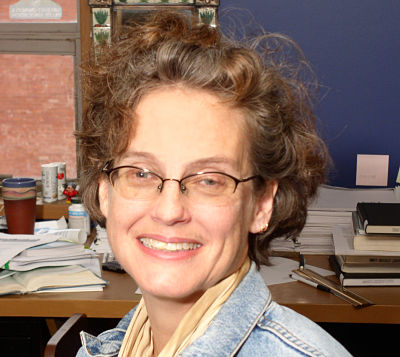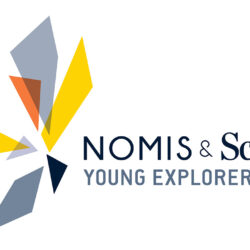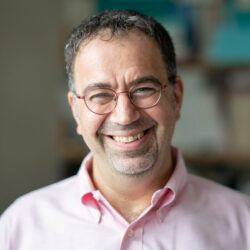 Recognition
Recognition Five Questions with Scholar/Activist Christine Drennon

Geographer Christine Drennon’s work on and off campus in San Antonio has earned her this year’s Marilyn J. Gittell Activist Scholar Award.
Christine Drennon, a Texas geographer whose youth and professional life have given her a front-row seat to see how access and equality play out in American cities, has received the annual Urban Affairs Association award for a scholar/activist.
She was nominated by Trinity University’s Arturo Madrid, a humanities professor who has spent a large part of his illustrious career connecting the campus with the area’s Latino heritage. Citing her grit and research that brought more government services like pre-kindergarten sites and probation officers to at-risk neighborhoods, Madrid said Drennon’s work “exemplifies field-based urban scholarship.”
The UAA-SAGE Marilyn J. Gittell Activist Scholar Award is named for Marilyn Jacobs Gittell, an outstanding scholar and a community urban activist who wrote seminal works on citizen participation, was founding editor of Urban Affairs Quarterly (now known as Urban Affairs Review) and was an impassioned participant in one of the most controversial social experiments of her time, the decentralization of New York City’s schools. Honorees are urban scholars who have engaged in field-based research that incorporates direct engagement with local residents and organizations in the area where the Urban Affairs Association conference is being held; this year’s conference takes place in San Antonio from March 19-22.
Drennon came to Trinity a dozen years ago, a geographer, it’s been noted, who came to a school without a geography department. She settled into the Sociology and Anthropology Department and, says Madrid, quickly started exploring the nettlesome questions of poverty, crime and access to services in San Antonio’s Eastside, historically black neighborhoods that are now mostly Hispanic. In 2009 she became head of the school’s pioneering Urban Studies Program. Her campus work centers on urban geography and community development, particularly understanding how an urban area’s opportunity and inequality are situated geographically. Off campus, she has been the research director for the Promise and Choice Neighborhood Planning Grants for the city of San Antonio and for the Choice Neighborhood Implementation project.
“I’m from the inner-city; the inner-city is home to me,” she noted in explaining how she came to study urban environments. She was brought up in Rochester, New York during a period that saw first the civil rights struggle on the 1960s and then the Rust Belt decay of the 1970s; her own family left the inner-city for the suburbs. Ultimately she receibed a master’s from the University of Wisconsin, Madison and a Ph.D. in urban geography from the University of Texas, Austin. “I went from resident of the city (growing up and living in it) to student of the city (studying it and teaching about it) to activist in the city (fighting for it) when the three began to overlap.”
Her activist was sparked when she moved to San Antonio. “I guess for me it took personal experience, but when my kids were receiving a second-rate education because of where we lived, yet my colleagues’ kids were receiving a first-rate education because they lived a few miles away, resident, student, and activist collided as I was struck by the fundamental insight that this was unjust, that I had the resources and the means to know how it came about–this was in no way a natural state of affairs–and that I truly believed that if I brought those things together I could change them. Well, I’m still trying.”
What lead you to Trinity and San Antonio’s Eastside? What’s the area like, and what makes it a good region for study?
Trinity is one of the few liberal arts universities with an undergraduate urban studies program AND that is located in a major city – what an opportunity. San Antonio is the seventh largest city in the country – but not only is it big, so too is it said to be the city of the future. The demographics of San Antonio today are said to be those of Texas in 10 years and of the United States in 30. At the same time we are a poor city, but also have the largest Latino middle class of any city in the country. What an ideal place to teach the next generation of urban leaders, scholars, and activists about cities. The country is watching San Antonio, partly because of the brilliance and potential of our mayor, but also because of the makeup of the city. Can we figure out how to deliver equal education opportunities to non-white students across this city? Can we figure out how to house a population that cannot access housing through the private market? Can we figure out how to think and act systemically, so we preserve our underground water source?
Previous winners
Previous winners of the Marilyn Gittell Award are last year’s honoree, Kitty Kelly Epstein, a professor of education and urban studies; John M. Wallace Jr., in the School of Social Work at the University of Pittsburgh; Marla K. Nelson of the Department of Planning and Urban Studies at the University of New Orleans; Beverly Wright, founder of Dillard University’s Deep South Center for Environmental Justice; and William P. Quigley of the Loyola University New Orleans School of Law.
When I first came to San Antonio, I had two school-age kids and wanted to buy a house. There are 18 school districts in San Antonio. Despite my insistence on wanting to live in the older sections of the city, my confidence that I could augment my children’s education on my own if their schooling was lacking, and my true desire to put them in schools reflective of the larger population of our new city (which is non-white) I was steered heavily into Anglo, suburban parts of the city. As you can imagine, as a mother and home buyer this experience was frustrating; but as a geographer it was utterly fascinating. How and why was this city carved into 18 different school districts? How did they come to be accepted as a natural part of the landscape, such that they now are the template we use to organize ourselves? Once settled (and yes, in the inner-city school district), this was my first research project in San Antonio (on the history of the creation of the school districts). That first research project caught the attention of MALDEF (the Mexican American Legal Defense and Education Fund), for whom I served as an expert witness in their last round of education-funding litigation.
My daughter’s elementary school served the inner-city neighborhoods on San Antonio’s Eastside. I got to know the Eastside through her friends, and their families. Driving her to sleep-overs gave me insight into daily life of the families who live there. When the school district threatened to close some of our Eastside schools, my interest in the area went from personal to political, and then to professional.
Could you talk about your work on and off-campus and what excites you about it? Are you making a difference?
At the turn of the 20th century, the presidents of American Ivy League universities were debating the role of the university in the 20th century. Was it to be aristocratic and contemplative, thus following a Platonic model, or democratic and activist, as John Dewey advocated? One hundred years later, the debate continues; do we continue to serve the elite, thus reproducing the same inequalities in our communities with every graduating class, or do we work toward a true democratic society – teaching it, modeling it, helping to create it? Esoteric ideas to be sure, but when I arrived at Trinity 11 years ago I found myself struggling with them.
Soon after my arrival, I realized quickly that I was teaching my students skills that most non-profit organizations pay hundreds and even thousands of dollars for. I was giving my students the skills that would launch their careers, and ensure their financial success for the rest of their lives, and I was doing so in one of the biggest and poorest cities in the United States. Our non-profit organizations, which work diligently to get services to the poor, advocate for preservation of the aquifer, and strive to offer an equal education to the children most difficult to teach, cannot access the skills I was teaching – they are too expensive, too specialized, and too time consuming to even learn, much less use. In effect, I was reproducing inequality by imparting valuable skills to those who could afford them while denying them to those who could not. That year, I began pairing students with community organizations so they might learn those skills while applying them to real-world problems in our community – thus building partnerships in the community, rendering a valuable service to our non-profit organizations, making the community aware of the resources available at Trinity, and, perhaps most importantly, modeling democratic values by educating our students in situations where they meet face-to-face with the inequalities they will inherit.
Am I making a difference? I do think I have made a difference on campus, where our Urban Studies Program is flourishing and is known as the hotbed of activists. In the community? That’s harder, but that is where my heart lies and that is where I work every single day.
You originally studied photography at Rochester’s famed program. How has that training influenced your professional work, especially now in San Antonio?
I am a geographer by training, and my undergraduate training was in photography. As I reflect on that, it makes so much sense, because I need to see, hear, touch, taste, feel everything before I truly understand it. I’ve thought a lot about this path over the years. None of it was intentional – I truly did follow my heart and intuition as I made decisions when I was young. I studied photography in college; being from Rochester, who didn’t study photography? That’s all we knew! But I was raised in Rochester and Utica – and was fascinated by neighborhoods. I grew up in an Italian and Irish neighborhood in the inner-city in Utica, New York. My parents later moved to the suburbs of Rochester; where was the noise? Where were the smells? Where was the life? How to understand that change? How to capture that change? How to express that change? It was so boring! I yearned for the old neighborhood.
As I got older, I returned frequently to my grandparents, who had remained on St. Jane Avenue. How to capture the essence of the old neighborhood? First, in pictures. Later, as a geographer, through words and maps and stories. Geography and photography are just two different ways to study and understand places.
Would you describe the interplay between academia and activism/advocacy in your work? It’s the focus of the Gittell Award, but not every scholar is comfortable bridging the two.
I actually do not want to be comfortable in it either. Discomfort keeps us aware, conscientious, and humble. I do not provide direct service to anyone. So what is my role at the table, with service providers who struggle daily with budgets, staffs, resources to reach into our inner-city neighborhoods? With city mangers and politicians, who are making decisions that impact people’s daily lives? What do I have to offer? I struggle with that daily.

Christine Drennon gives an overview of San Antonio during a visit by officials with the School Reform Initiative last winter. (Photo: SRI)
Most recently I have been doing project assessment. It sounds boring, much less exciting than service delivery, programming, and politics, but in that position, I bring two additional voices to the table – two voices that are not usually included in decision-making: the voices and perspectives of the community and the voices and perspectives of the scholars. An interesting combination I believe. But these two ‘stakeholders’ offer tremendous insights into life in the inner-city neighborhoods: one through experience and the other through theory and abstraction. I think we need both to alleviate and reverse the problems and injustices we have inherited and that we reproduce. A favorite phrase in San Antonio is “the knowledge is in the room” — well, I do not believe that the knowledge is always in the room. Sometimes I think we need to throw the doors open wide and invite in the community and the scholars in order to truly understand both the forces at work (from the scholars) and the materialization of those forces in daily life in the neighborhoods (from the community). Only THEN can we begin to work effectively to alleviate injustice.
So in essence, I believe I bring academia and activism together when I do this effectively.
What advice do you have for a young scholar-activist who wants to follow in your steps, or those of Marilyn Gittell?
Do not deny or be ashamed of the benefits and advantages (even the luxuries) we have being associated with the academy. Instead, embrace them, but do not flaunt them. Use them as they should be used – or maybe I should say as they have the potential to be used. Share them. We have the time for reflection; we have resources for analysis and understanding; and we have students for energy, help, and idealism. All of those things have enabled me to use my position to often take an outside, etic position in relation to the city, and to represent voices that usually are not invited to the table. Because I am not seen as benefiting personally from the work I do, people tend to trust me. I remind myself daily to respect and honor that trust.
























































































